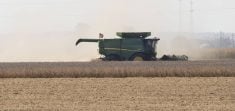The Canadian pork industry needs to roll up its sleeves and get to work during the 30-day tariff reprieve announced on Feb. 3, industry experts warn.
A 25 per cent tariff on Canadian goods, including pork exports, to the United States was set to take effect Feb. 4, followed by retaliatory action from Canada on products from the U.S. With less than 24 hours before that first tariff volley, the dispute was delayed until March following discussions between Prime Minister Justin Trudeau and U.S. President Donald Trump.
The pause was a relief to Canadian agricultural industries of all stripes, but pork officials said they remain concerned about economic effects should the narrowly averted trade war become reality.
Read Also

Beekeepers want financial protection against tropi mite
What happens to beekeepers if the deadly tropi mite reaches Canada? Discover why farmers want robust compensation to protect pollination.
“I think the two words would be ‘uncertainty’ and ‘concern,’” said Cam Dahl, general manager of Manitoba Pork. “We cannot waste these 30 days. The threat is still very, very real.”
Why it matters: The Canadian pork industry, along with other agricultural sectors, has 30 days to prepare for tariffs that could hit at trade, jobs and food prices. They say swift collaboration crucial for stability.
Dahl is calling for the industry to actively engage with partners in the U.S. to push the message that tariffs and border disruptions would be harmful to customers and farmers in both the U.S. and Canada, citing Manitoba Pork’s outreach to Iowa and Minnesota as an example.
That has echoed the tone from other sectors, such as beef, as well as the Manitoba government. Although joining in on announced retalitatory actions in early February, the province had stressed preserving trade relationships and measures like a Washington D.C. trade office and a advisory U.S. Trade Council, made up of various industries including agriculture, in the prior weeks and months.
It’s also integral for all Canadian agricultural groups to come together across all sectors, Dahl said.
He’s encouraged to see moves like the Keystone Agricultural Producers trade advisory committee, which bring the various commodity value chains together, he noted. Dahl is hoping to see that kind of collaboration between governments and the industry as well.
“We should be visiting key state governments and U.S. industry stakeholders together. We need to have a strategic plan for agriculture and food trade to get this done,” he said.
His priorities for government include key collaboration between Manitoba and other provinces, especially Saskatchewan and Alberta, on a strategic plan for agriculture and food trade. That would include details on how the Prairie provinces will support and complement each other, Dahl added.

Play-by-play on tariff hits
Any disruption to pork or pig movement across the border will hurt the integrated North American market, the pork sector has repeatedly argued. That includes isoweans shipped by Manitoba farmers to Iowa, where they’re finished and processed before being shipped to Mexico to be deboned, smoked and processed. Then, most of the processed meat is shipped back to Canada and the U.S.
“If a tariff war comes to pass, each [of those steps] will face a tariff, increasing the cost of ham at the retail level,” Dahl said.
Additionally, the demand for Canadian isoweans and pork products in the U.S. would be significantly reduced as tariffs increased price.
“This will impact farm income, processing jobs in Manitoba, and consumers on both sides of the border,” Dahl said.
Dickson Gould, president of The Progressive Group of Companies, agrees with Dahl’s prediction, though the current market would suggest less of a price drop on isoweans than the sector has seen with past demand issues.
“If we were looking at historical numbers, that could be somewhere between right around $16, $17 per isowean, which is going to make it very, very difficult,” Gould said. “I think today, with the way the prices are, it would have a lesser impact, but probably in a couple months we’ll be starting to look at…fall pricing. That’s going to be very challenging.”
Tariff uncertainty is already having an impact is already having an impact on producers, Dahl added, in the form of whether contracts are renewed.
“Even just the threat of the tariff…has a significant impact, very quickly.”
Uncertainty builds
Tara Terpstra, chair of Ontario Pork, says the Canadian pork industry supports thousands of jobs, fosters economic growth and contributes to food security across North America.
“These tariffs threaten to disrupt that balance, leading to job losses and increasing food prices for consumers,” Terpstra said.
Ontario Pork, she added, is working closely with government officials and industry partners to push for the removal of the tariff threat.
Alberta Pork’s executive director, Darcy Fitzgerald, pointed to broader trade issues that add to the uncertainty.
“It’s not just the tariffs. It’s also talk about voluntary country-of-origin labelling, and then the reopening of the Canada-United States-Mexico Agreement, having to do that in 2026,” Fitzgerald said. “It’s a lot of trade issues for sure to look at.”
Bill Alford, general manager of H@MS Marketing Services Co-op, based in Headingley, Man., said a main concern on producers’ minds is the lack of alternative markets.
“Manitoba particularly exports a lot of live hogs into the U.S. market,” he said. “There’s no real alternative — overnight, anyway.”
Taking the long view
A prolonged trade dispute could force the industry to reconsider long-term strategies.
“Certainly, the hog industry would have to look at what can they do longer term if this is the reality we’re faced with,” Alford said. “It is a long, protracted outlook.”
Currently, many producers are in close contact with their customers, trying to find a solution to the looming problems.
“Everybody’s talking to their buyer, or the customers that they do business with, trying to figure out if there’s any type of cost-sharing until we figure this thing out,” Gould said.
Despite the challenges, Fitzgerald said collaboration remains key.
“We work really well together with our U.S. counterparts. It’s quite an integrated system in the pork industry,” he said. “We really depend on each other to move pork back and forth and to work together.”
Gould underscored the importance of relationships between producers and customers on both sides of the border.
“There’s a long, outstanding relationship with a lot of our customers in the U.S., and so we’ve been through difficult things before. We sit down and try to work everything out. There are really no issues with American producers or any issues with American processors. We’re just dealing with some administration issues, and so hopefully we can figure out strategies to lessen the blow, but we won’t be able to eliminate the blow,” he said.
With less than 30 days before the tariffs could take effect, industry leaders say they will continue pushing for a resolution.
















